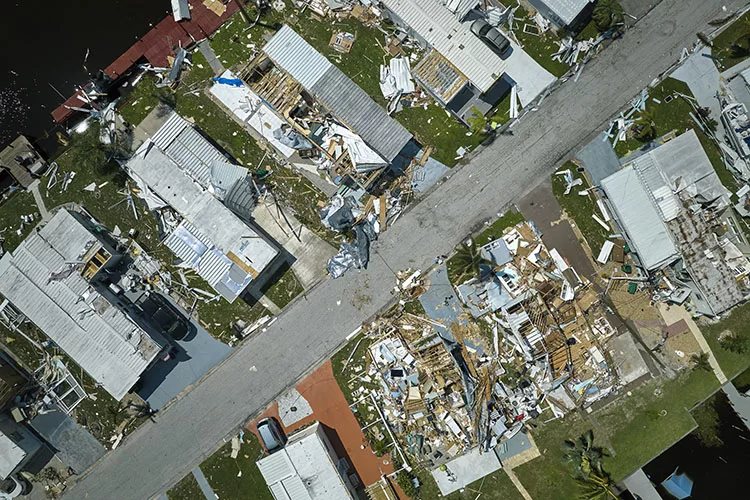When natural disasters happen, a sense of solidarity often develops in the affected communities. Neighbors band together, help each other out and rebuild. Regardless of where you live, the story of a fresh start could develop from the devastation. Most of the bounce-back stories are enabled by insurance payouts. In scenarios where people are underinsured or not insured, the new beginning plot often involves relocation and consolidation.
The concept of climate migration is growing in North America. The where and how prospects of rebuilding change with insurance coverage policy updates.
When I was in high school, a tornado destroyed my aunt and uncle’s house in Monett, Mo. The whole family made it to the basement and survived the storm. They had additional tornado insurance for the property since they moved from Boston a few years prior and were vividly aware of the potential for big storm damage.
After their insurance check cleared, they purchased a house about 10 miles away and were back on track. The kids stayed in the same schools; they went to the same grocery store for food.
While tornados can be incredibly destructive, especially in states part of Tornado Alley (frequently the Great Plains area), they aren’t accompanied by the same collateral damage as a hurricane. In a hurricane, the entire ZIP code can be under the water of the storm surge. In some of the low-elevation coastline counties in the United States, the storms are happening faster than the insurance money is coming in.
In September, Hurricane Idalia made landfall in Florida. According to CNN, Idalia was the eighth major hurricane in the Gulf Coast region in the last six years (https://cnn.it/3tyziWw). How does that impact the insurance landscape?
Another CNN article (https://cnn.it/3Q6Loz4) explains: “Nearly 7 million properties, almost 1 in 20 buildings, have already experienced price surges or have been dropped by insurance companies, First Street [Foundation reported (https://bit.ly/3Fb86A4)]. Most of those properties are located either in wildfire and flood-prone California or hurricane-prone Florida, Louisiana and Texas.”
If you live in an area where the insurance premiums skyrocket or you are dropped from coverage, what are the ripple effects for the PHCP community? Automobile insurance can’t be far behind. If somebody owns a plumbing service company in Key West, Fla., could those trucks also become uninsurable? How many plumbing service mom-and-pop companies could afford to repurchase their fleet of trucks with cash, post-hurricane?
It is easy to get mad at the insurance companies for pulling the rug out from under people who have paid premiums for decades. However, their business model doesn’t maintain profitability if they frequently pay out enormous claims.
If somebody wanted to open a roadside stand selling umbrellas on the road to Mount Washington in New Hampshire — one of the windiest places in the United States, with a record speed of 231 miles per hour (https://bit.ly/3RRIC1R) — and went to their insurance company asking for full coverage for property damage, the cost of the premiums would either be high enough to cover the lost inventory every week or a policy would not be issued in the first place.
Playing Both Sides
In a less exaggerated fashion, a similar situation is unfolding across climate change-sensitive areas of the world.
Insurance companies are pulling back from areas experiencing relentless climate damage, CleanTechnica reports (https://bit.ly/3QcIGZa). State Farm Insurance decided in May 2023 to stop issuing new home insurance policies in parts of California most prone to wildfires.
Farmers Insurance followed suit in the Gulf Coast states by announcing it will not renew “almost a third of the policies the company has written in Florida, and close to 20 home insurers in hurricane-prone Louisiana are either pulling out of the state or declaring insolvency.”
One could argue that the rest of the policyholders, outside of those areas mentioned above, benefit from shedding the riskiest properties from their portfolio and prices for premiums could stabilize as a result.
However, insurance companies are playing both sides of the climate change issue. CleanTechnica notes, “The top two U.S. property and casualty companies, Berkshire Hathaway and State Farm Insurance, hold 44 percent of total fossil fuel-related assets owned by the entire (insurance) sector.”
The big insurance companies hold more than $500 billion dollars in fossil fuel-related stocks.
From a fossil-fuel investment perspective, one could argue that insurance companies holding stock in a long-standing, stable asset is a good thing. If insurance companies only invested in wacky startup companies, they might default and leave the insured empty-handed.
One could also argue that it is, at a minimum, in poor taste to invest so much money in an industry that is part of the climate change problem. It would be like a dry cleaning company investing in a company manufacturing leaky pens. They make money when people need the ink cleaned out of their clothes, and they make money when the pens that potentially caused the issue are repurchased.
Are insurance companies financing the motive for reducing their customer base?
If the insurance industry keeps moving in this direction, the likelihood that people will rebuild in the same ZIP code after a storm dwindles. While it is hard to know what is fair in this insurance conversation, the best defense is to build or update buildings to be as resilient to climate disasters as possible.
Fixing 5 percent of a house after a storm is a much smaller payout for insurance companies than a teardown-rebuild scenario. In our extended construction/PHCP community, one of the only things we can act on is how durable we build structures.





